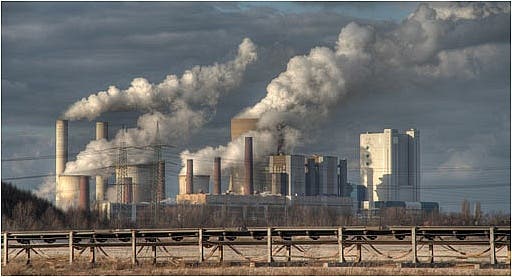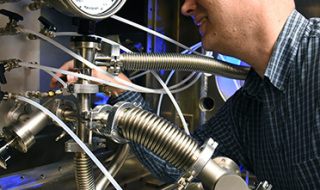With the EPA setting stricter guidelines for NOx emissions fired by coal plants, the industry is now in a position where it needs new, advanced technologies that clean flue gases. Such a solution might came from the U.S. Naval Research Laboratory (NRL), which recently partnered with a leading coal corporation to implement its electron beam technology. The system works by zapping flue gases with a high frequency electron beam which break molecular bonds in nitric oxide and nitrogen dioxide (NOx), leaving clean oxygen (O2) and nitrogen (N2) instead. If the electron beam flue gas zapper is found reliable, it could prove to be a lot cheaper than currently established catalytic reduction systems.
Zapping exhaust gases with electrons


(Photo: U.S. Naval Research Laboratory/Jamie Hartman)
The concept has already been proven on a small scale using a mixture of just NOx and nitrogen. When the powerful pulse of electrons leaves the cathode from a thin foil of steel or titanium, it hits the NOx which absorbs the energy and breaks the bonds. Firing is made in short pulses – several times a second for long durations. Considering NOx bonds typically break at 4 electron volts (eV) of energy, then a 400,000 volt electron beam can break 100,000 bonds, making it highly efficient according to NRL researchers.
Reality proves to be a lot more complex than the lab setting, though. Flue gases resulting from burning coal are made up of a lot of compounds like nitrogen, carbon dioxide (CO2), oxygen, water vapor, sulfur oxide (SOx), and particulates—depending on what the coal is.
“CO2 wasn’t a problem, but the oxygen threw us for a loop,” says Dr. John Sethian, the plasma physicist leading the project at NRL. “It’s one of these up and downs, you try not to get emotionally involved.” He thinks that problem is now solved, but others may arise before the team’s ready to demonstrate the electron beam at a power plant. “I’m confident that we’ll solve all the problems, but I can’t guarantee it,” he says. “I will guarantee, on the other hand, that we’ll figure out what’s going on.”
At the moment, the team is tweaking their system to make the electron beam work in practice. Their proposed pilot system involves splitting the coal plant’s exhaust into several narrow ducts, each treated with a pair of electron beams. Basically, it sounds like a multi-stage filter, where the flue gas become cleaner and clear as it passes through each successive step of the system. Narrower ducts would allow the electron beam to reach all the gas more efficiently; having several systems allows for regular maintenance.

A while ago, ZME reported how coal consumption has increased 9x faster than wind energy and 40x than solar since 2003, and the trend is expected to continue onward in the coming decades. With this in mind, we must no kid ourselves. Coal is here to stay for a while longer, and we have to make the best of it. The U.S. Environmental Protection Agency (EPA) has determined NOx contributes to ground-level ozone, pollution, and respiratory problems, and has set a margin of 100 million parts per million. This margin is set to become even tighter at 30 ppm. Coal plants now rely on what’s called selective catalytic reduction system, but these can be extremely expensive. NRL’s technology – again if proven to work reliably at the large scale – could turn in the same flue gas quality at 10 to 20 percent of the cost.
Source: NRL press release
Was this helpful?



